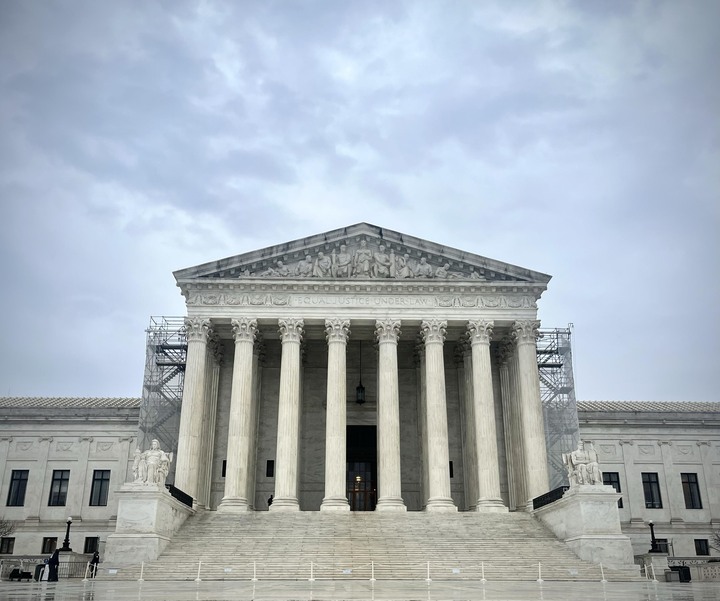WASHINGTON – The Supreme Court wrestled with how to interpret a 1934 statute during oral arguments on Feb. 28 in a case to determine whether bump stocks, used in the 2017 Las Vegas mass shooting, should be classified as machine guns.
The justices wrangled with the National Firearms Act’s ambiguous definition of “machine gun” during Garland v. Cargill.
“That’s the language we’re stuck with,” lamented Justice Brett Kavanaugh, acknowledging the act was originally passed as a direct response to gang violence during the Prohibition era.
Bump stocks are defined by the Bureau of Alcohol, Tobacco, Firearms and Explosives as “devices that allow a semiautomatic firearm to shoot more than one shot with a single pull of the trigger.” The two sides diverged in their definition of trigger.
A bump stock harnesses the recoil energy from the initial trigger of a firearm, allowing it to continuously shoot without active intervention after the first shot.
In 2002, the ATF deliberated over a particular bump stock known as the “Akins Accelerator.” The ATF determined that under the 1934 statute, the bureau could not regulate the Atkins Accelerator because it required repeated pulls of the trigger to fire multiple shots.
However, in 2006, the ATF revisited its ruling and determined that bump stocks that the Atkins Accelerator were machine guns.
Since then, many different bump stocks have emerged, leading to several ATF rulings between 2008 and 2017 that many did not qualify as machine guns.
After the Las Vegas music festival shooting that killed 60 people, the deadliest mass shooting in U.S. history, the ATF under the Trump administration redefined bump stocks as machine guns.
The decision exposed bump stock owners to criminal liability if they did not destroy or turn in the devices by March 26, 2019.
Michael Cargill, the owner of Central Texas Gun Works, challenged the ruling when it went into effect in 2019. The federal district court sided with the ATF, contending that the ruling abides by the best interpretation of the statute.
“The case is about whether or not the ATF have the authority to promulgate this rule, not whether or not it is constitutional under the Second Amendment to regulate bump stock,” Kelly Roskam, director of law and policy at the Johns Hopkins Center for Gun Violence Solutions, said in an interview with Medill News Service.
“Those weapons do exactly what Congress meant to prohibit when it enacted the prohibition on machine guns,” attorney Brian Fletcher argued before the Supreme Court on behalf of Attorney General Merrick Garland, who represents the government.
Fletcher maintained that it would be “irresponsible” for the ATF to overlook their previous judgment that bump stocks were not machine guns in light of the Las Vegas shooting.
Cargill’s argument rested on the movement of the trigger back and forth between shots and the human intervention required to keep shooting. In contrast, Garland’s position hinged on the technicality that the shooter is no longer actively controlling the trigger after the first shot and thus is initiating a continuous cycle of fire.
The U.S. Appeals Court for the Fifth Circuit sided with Garland, judging that Congress willfully excluded trigger finger movement when constructing their statute. Cargill soon after appealed this decision to the Supreme Court.
“The trigger is the device that initiates the firing of the weapon. A bump stock does not change the trigger in any way,” Jonathan Mitchell, attorney for Cargill, said during oral arguments.
Justice Ketanji Brown Jackson doggedly questioned Mitchell, homing in on the intent of Congress.
“Why would Congress want to prohibit certain things based on whether the trigger is moving as opposed to certain things that can achieve this, you know, lethal kind of spray of bullets?” asked Jackson.
Both Jackson and Justice Elena Kagan maintained that though the mechanisms may differ, a semi-automatic equipped with a bump stock and a typical machine gun have the same capability.
“At some point, you have to apply a little bit of common sense to the way you read a statute and understand that what this statute comprehends is a weapon that fires a multitude of shots with a single human action,” said Kagan.
Mitchell, however, continued to insist upon a difference between the function of bump stocks and that of machine guns.
“It has a very high rate of fire, but it’s not automatically fired,” replied Mitchell.
If the court rules in favor of Garland, the ban on the ownership and transfer of bump stocks will remain in effect.
If the justices side with Cargill, Americans will be able to possess and purchase bump stocks unless Congress or state legislative bodies enacts new laws.
“The ATF doesn’t have the power to make something a crime that wasn’t a crime before. It’s not a crime to violate the rule,” said Fletcher. “It has been and always will be a crime to violate the statute.”


